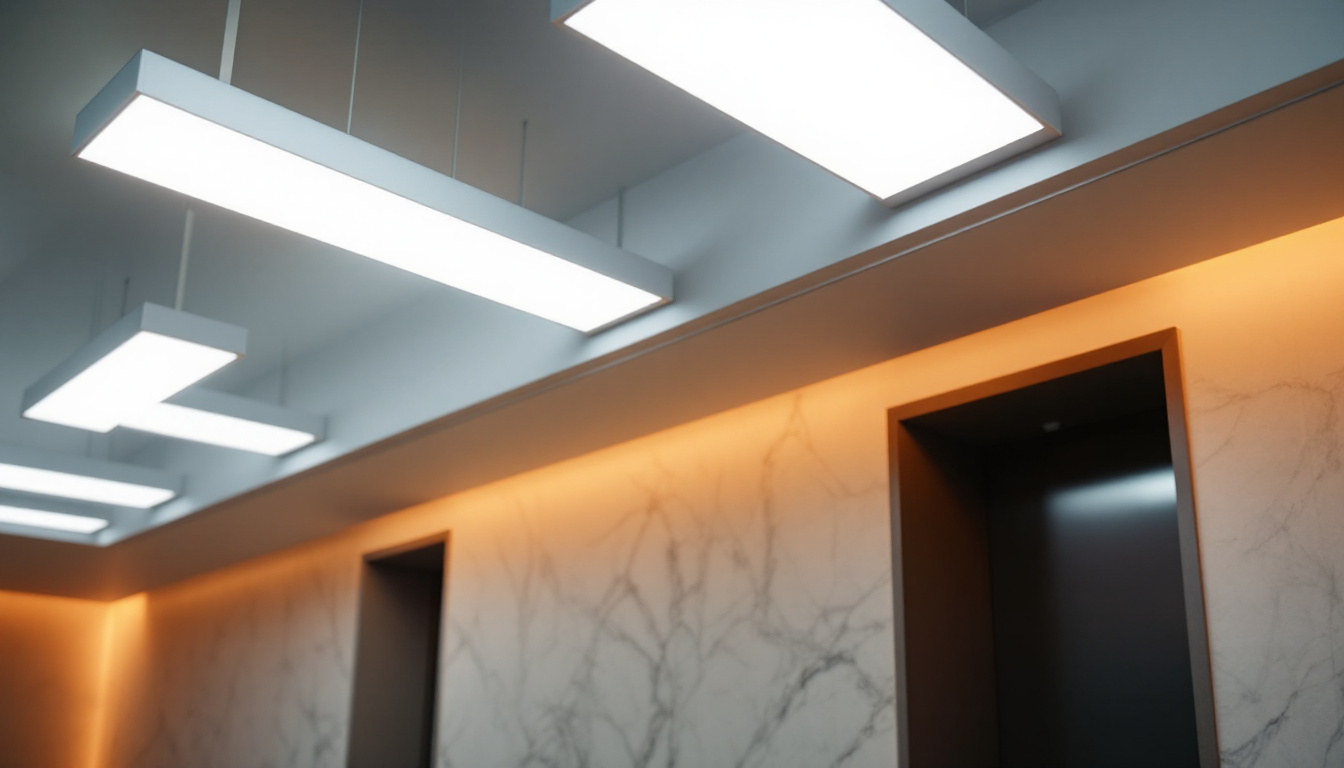
In the ever-evolving world of lighting design, understanding brightness is crucial for creating effective and efficient lighting solutions. As technology advances and energy standards become more stringent, lighting contractors must stay informed about what constitutes good brightness for various applications. This article explores the factors that influence brightness, the importance of future-proofing lighting projects, and practical tips for ensuring that your lighting installations meet both current and future needs.
Brightness, often measured in lumens, is a key factor in determining how well a space is illuminated. It is essential for lighting contractors to grasp the nuances of brightness to ensure that their projects meet the needs of clients while adhering to industry standards.
Lumens quantify the amount of visible light emitted by a source. Unlike watts, which measure energy consumption, lumens provide a clearer picture of a light source’s actual output. This distinction is vital for selecting the right fixtures for specific applications, whether it be residential, commercial, or industrial settings.
When evaluating brightness, it is crucial to consider the intended use of the space. For instance, a cozy living room may require fewer lumens compared to a well-lit office space where clarity and focus are paramount. Understanding these requirements helps contractors make informed decisions about lighting solutions. Additionally, the layout and function of the space can greatly influence the perceived brightness; an open-plan office may require more lumens to ensure even distribution across the area, while a small, intimate dining room could benefit from softer, more focused lighting.
Several factors influence the perception of brightness in a space. These include the color temperature of the light source, the reflectance of surfaces, and the layout of the lighting design. Each of these elements plays a significant role in how light is distributed and perceived.
Color temperature, measured in Kelvin, affects the ambiance of a space. Warmer tones (around 2700K to 3000K) create a relaxed atmosphere, while cooler tones (above 4000K) promote alertness and productivity. Contractors must consider these variations when selecting fixtures for different environments. Furthermore, the reflectance of surfaces—such as walls, ceilings, and floors—can amplify or diminish the effectiveness of the lighting. Light-colored surfaces tend to reflect more light, enhancing brightness, while darker colors absorb light, which may necessitate the use of higher lumen outputs to achieve the desired illumination levels. The strategic placement of lighting fixtures, such as wall sconces or recessed lights, can also help to optimize brightness and create a balanced lighting scheme that enhances the overall aesthetic of the space.
Future-proofing lighting projects involves anticipating changes in technology, regulations, and client needs. By designing adaptable lighting systems, contractors can ensure their installations remain relevant and efficient for years to come.
LED technology has revolutionized the lighting industry, offering energy efficiency and longevity. Unlike traditional incandescent bulbs, LEDs consume significantly less energy while providing the same, if not greater, brightness levels. This shift not only reduces operational costs but also aligns with growing sustainability initiatives.
When future-proofing a project, incorporating LED fixtures is a wise choice. They are available in various color temperatures and styles, allowing for flexibility in design. Additionally, as LED technology continues to evolve, new advancements can be integrated into existing systems, enhancing performance without requiring a complete overhaul.
Moreover, the durability of LED fixtures means they often have a longer lifespan compared to traditional lighting options, which translates to lower maintenance costs over time. This longevity is particularly beneficial in commercial settings where lighting is used extensively. The ability to withstand frequent on-off cycles without a reduction in performance further underscores their reliability, making them an ideal choice for both residential and commercial applications.
Smart lighting systems are becoming increasingly popular, offering enhanced control and customization. These systems allow users to adjust brightness, color temperature, and even scheduling through mobile applications or voice commands. By integrating smart technology into lighting projects, contractors can provide clients with a modern, user-friendly experience.
Future-proofing with smart lighting not only adds value to the project but also positions contractors as leaders in innovation. As more clients seek automated solutions, having expertise in smart lighting will be a significant advantage in the competitive market.
Additionally, smart lighting systems can enhance energy efficiency by utilizing sensors that adjust lighting based on occupancy or natural light levels. This capability not only contributes to sustainability goals but also creates a more comfortable environment for occupants. Furthermore, the integration of smart lighting with other smart home technologies, such as security systems and climate control, allows for a cohesive and comprehensive approach to home automation, making it an attractive option for tech-savvy clients looking to enhance their living spaces.
Determining the appropriate brightness for various spaces requires a systematic approach. By considering the function of the area, the desired ambiance, and the specific requirements of the occupants, contractors can create tailored lighting solutions.
In residential settings, the brightness requirements can vary significantly from room to room. For example, kitchens and bathrooms typically require brighter lighting for functionality, while living rooms and bedrooms benefit from softer, ambient lighting.
A general guideline for residential lighting is to aim for about 100-200 lumens per square meter in living areas and 300-500 lumens in task-oriented spaces like kitchens. However, these numbers can be adjusted based on personal preferences and specific activities. Additionally, the use of dimmers can provide flexibility, allowing homeowners to adjust the brightness according to the time of day or mood. Incorporating layered lighting—such as combining ambient, task, and accent lighting—can further enhance the functionality and aesthetics of a space, creating a dynamic environment that adapts to various needs.
Commercial spaces often have more stringent lighting requirements due to their operational needs. Offices, retail stores, and warehouses each have unique brightness needs that must be addressed. For instance, office environments typically require around 300-500 lumens per square meter to ensure productivity and comfort.
In contrast, retail spaces may require brighter lighting to highlight products and create an inviting atmosphere. Aiming for 500-1000 lumens per square meter can enhance visibility and encourage customer engagement. Understanding these distinctions is crucial for contractors to deliver effective lighting solutions. Moreover, the integration of energy-efficient lighting options, such as LED fixtures, not only meets brightness requirements but also reduces energy consumption and operational costs. The strategic placement of lighting can also influence customer behavior; for example, well-lit displays can draw attention to specific products, while softer lighting in seating areas can create a more relaxed shopping experience. This thoughtful approach to lighting design can significantly impact both employee productivity and customer satisfaction, making it an essential consideration in commercial space planning.
Staying compliant with regulatory standards is essential for lighting contractors. Various organizations and government bodies set guidelines to ensure safety, efficiency, and performance in lighting installations.
Energy efficiency standards, such as those set by the Department of Energy, dictate the minimum performance requirements for lighting products. These regulations encourage the use of energy-efficient technologies, such as LEDs, to reduce energy consumption and environmental impact.
Contractors must stay informed about these standards to ensure their projects comply with local and national regulations. By prioritizing energy efficiency, contractors can not only meet legal requirements but also provide clients with cost-effective solutions.
In addition to energy efficiency standards, building codes and safety regulations play a vital role in lighting projects. These codes outline requirements for emergency lighting, exit signs, and general safety measures that must be adhered to in commercial and public spaces.
Contractors should familiarize themselves with local building codes to avoid potential legal issues and ensure the safety of occupants. Incorporating safety features into lighting designs not only enhances compliance but also builds trust with clients.
effective lighting design goes beyond mere brightness; it involves creating a harmonious balance between functionality and aesthetics. Contractors must consider various design elements to achieve optimal results.
Layered lighting involves combining different types of lighting—ambient, task, and accent—to create a well-balanced and versatile lighting scheme. This approach allows for flexibility in how spaces are illuminated, catering to different activities and preferences.
For instance, in a dining area, ambient lighting can provide overall illumination, while task lighting, such as pendant lights over the table, can enhance functionality. Accent lighting can be used to highlight artwork or architectural features, adding depth and interest to the space.
Integrating control systems into lighting designs allows users to customize their lighting experience. Dimming capabilities, color temperature adjustments, and programmable settings enable occupants to tailor the lighting to their specific needs and preferences.
By offering control options, contractors can enhance the user experience and promote energy efficiency. Clients will appreciate the ability to adjust lighting levels based on the time of day or activity, leading to increased satisfaction with the overall installation.
As the lighting industry continues to evolve, understanding brightness and its implications for lighting design is essential for contractors. By embracing new technologies, adhering to regulatory standards, and focusing on effective design strategies, contractors can future-proof their lighting projects and meet the diverse needs of their clients.
Ultimately, the goal is to create lighting solutions that are not only functional but also enhance the overall experience of a space. By staying informed and adaptable, lighting contractors can position themselves as leaders in the industry, ready to tackle the challenges and opportunities that lie ahead.
Ready to elevate your lighting projects with the perfect balance of quality and value? At LumenWholesale, we provide contractors with exceptional, spec-grade lighting products at unbeatable wholesale prices. Say goodbye to inflated markups and hello to a vast selection of reliable, high-performance lighting that meets the highest industry standards. Plus, with free shipping on bulk orders, you can secure premium lighting solutions at the best price, without any hidden fees. Don’t compromise on quality or cost. Discover wholesale lighting at the best value today and light up your future projects with confidence.

Discover the essentials of architectural square linear lights in this insightful guide tailored for lighting contractors.

Discover how outside LED lighting can enhance your business’s profitability in our comprehensive guide tailored for lighting contractors.

Discover everything lighting contractors need to know about Volt LED Lights in this comprehensive guide.

Discover how LED dimmable switches can revolutionize the workflow of lighting contractors by enhancing efficiency and reducing costs.